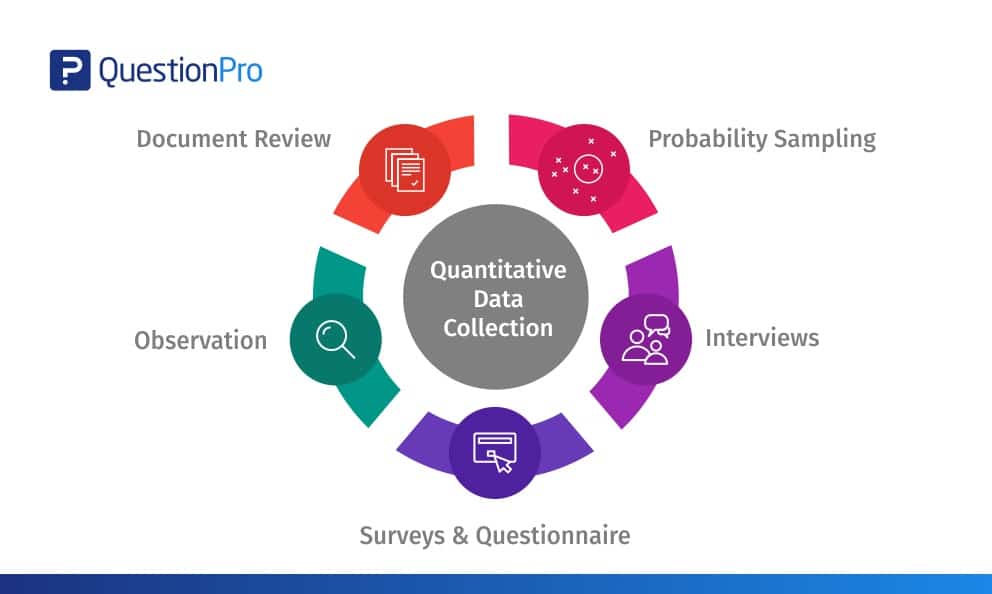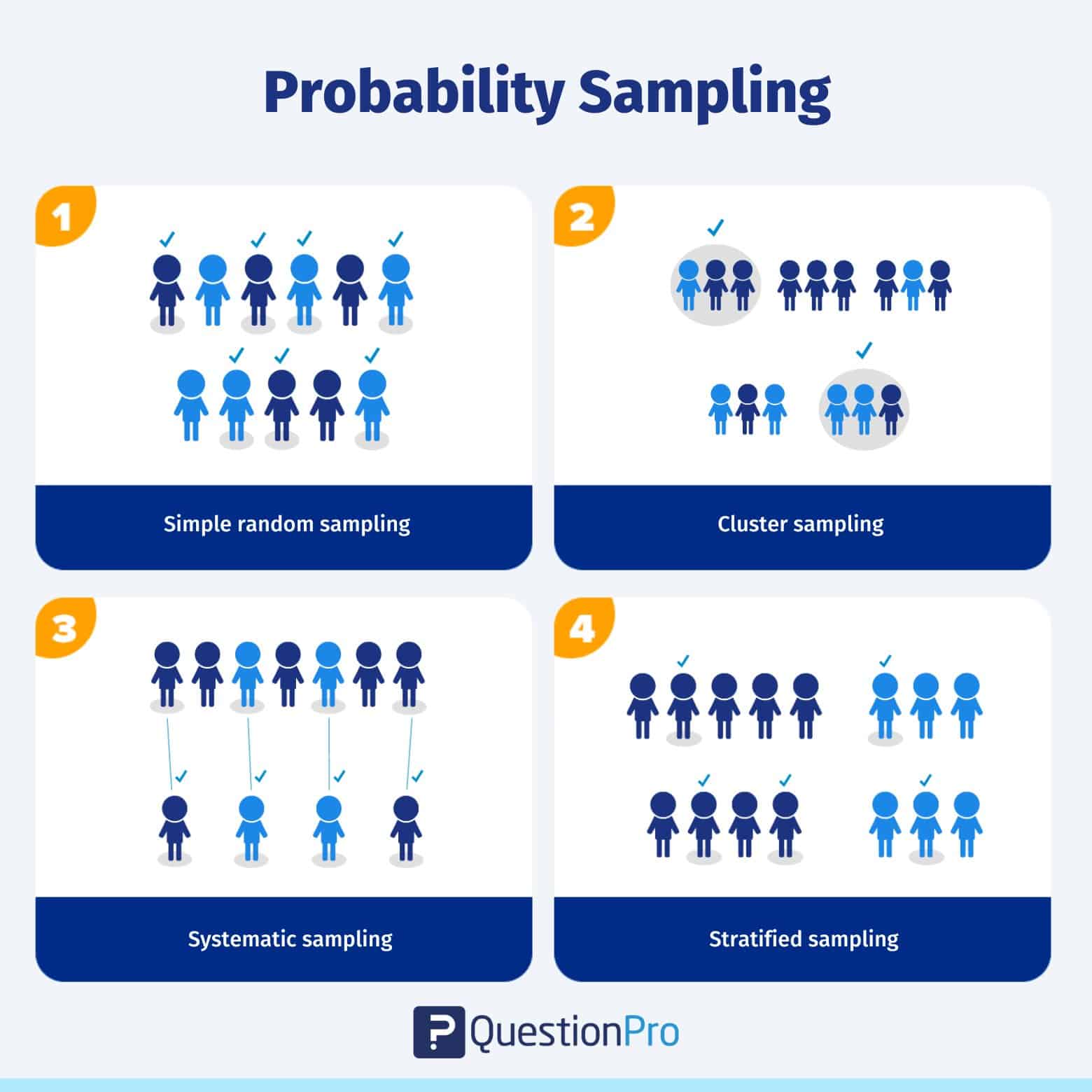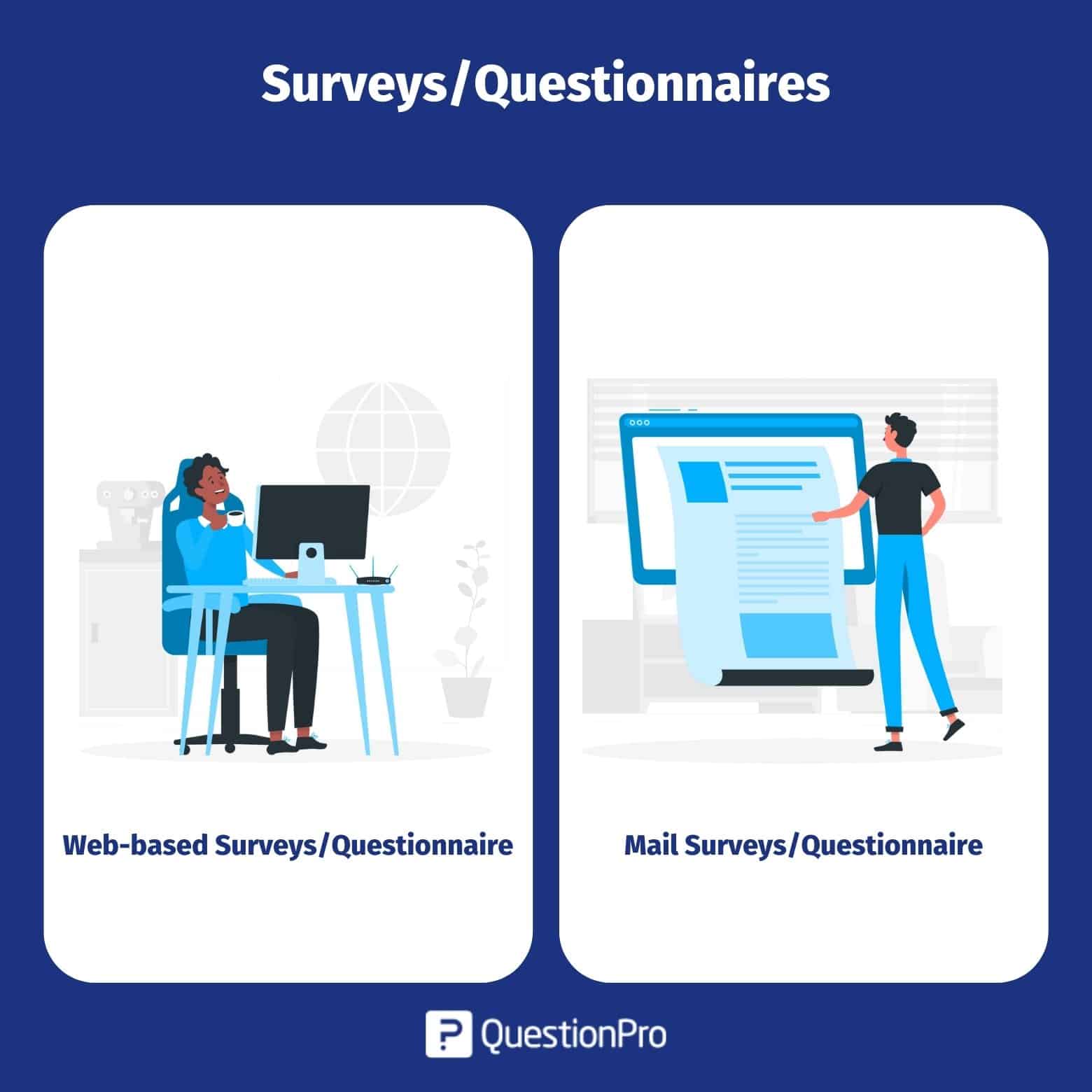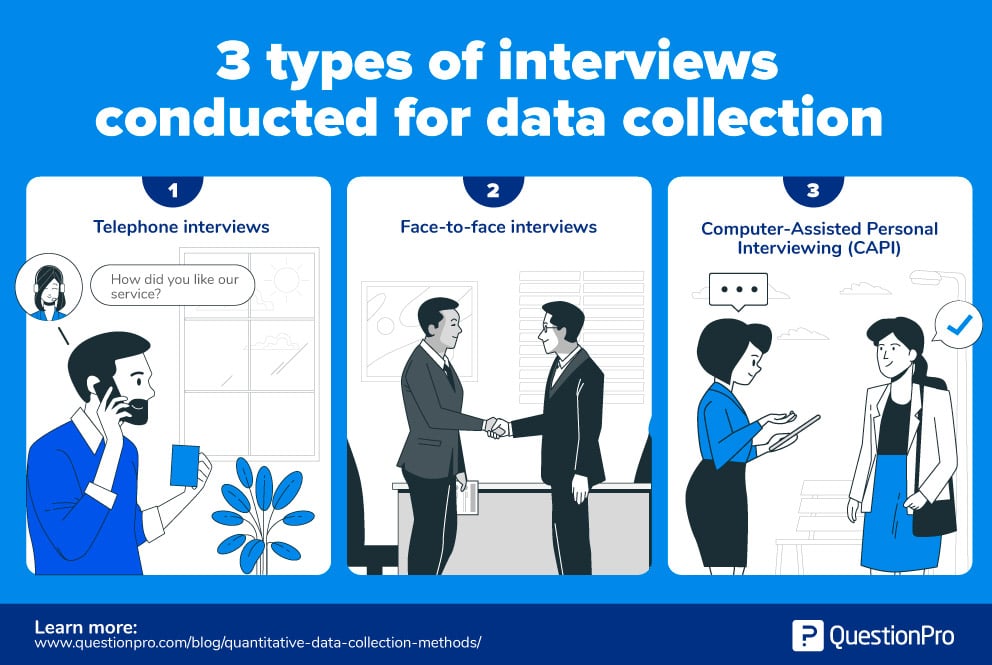
In contrast to qualitative data, quantitative data collection is everything about figures and numbers. Researchers often rely on quantitative data when they intend to quantify attributes, attitudes, behaviors, and other defined variables with a motive to either back or oppose the hypothesis of a specific phenomenon by contextualizing the data obtained via surveying or interviewing the study sample.
What is Quantitative Data Collection?
Quantitative data collection refers to the collection of numerical data that can be analyzed using statistical methods. This type of data collection is often used in surveys, experiments, and other research methods. It measure variables and establish relationships between variables. The data collected through quantitative methods is typically in the form of numbers, such as response frequencies, means, and standard deviations, and can be analyzed using statistical software.
LEARN ABOUT: Research Process Steps
Importance of Quantitative Data Collection
As a researcher, you do have the option to opt either for data collection online or use traditional data collection methods via appropriate research. Quantitative data collection is important for several reasons:
- Objectivity: Quantitative data collection provides objective and verifiable information, as the data is collected in a systematic and standardized manner.
- Generalizability: The results from quantitative data collection can be generalized to a larger population, making it an effective way to study large groups of people.
- Precision: Numerical data allows for precise measurement and unit of analysis, providing more accurate results than other data collection forms.
- Hypothesis testing: Quantitative data collection allows for testing hypotheses and theories, leading to a better understanding of the relationships between variables.
- Comparison: Quantitative data collection allows for data comparison and analysis. It can be useful in making decisions and identifying trends or patterns.
- Replicability: The numerical nature of quantitative data makes it easier to replicate research results. It is essential for building knowledge in a particular field.
Quantitative data collection provides valuable information for understanding complex phenomena and making informed decisions based on empirical evidence.
LEARN ABOUT: Best Data Collection Tools
Methods used for Quantitative Data Collection
A data that can be counted or expressed in numerical’s constitute the quantitative data. It is commonly used to study the events or levels of concurrence. And is collected through a Structured Question & structured questionnaire asking questions starting with “how much” or “how many.” As the quantitative data is numerical, it represents both definitive and objective data. Furthermore, quantitative information is much sorted for statistical analysis and mathematical analysis, making it possible to illustrate it in the form of charts and graphs.
Discrete and continuous are the two major categories of quantitative data where discreet data have finite numbers and the constant data values falling on a continuum possessing the possibility to have fractions or decimals. If research is conducted to find out the number of vehicles owned by the American household, then we get a whole number, which is an excellent example of discrete data. When research is limited to the study of physical measurements of the population like height, weight, age, or distance, then the result is an excellent example of continuous data.
Any traditional or online data collection method that helps in gathering numerical data is a proven method of collecting quantitative data.
LEARN ABOUT: Survey Sampling
Probability Sampling
A definitive method of sampling carried out by utilizing some form of random selection and enabling researchers to make a probability statement based on data collected at random from the targeted demographic. One of the best things about probability sampling is it allows researchers to collect the data from representatives of the population they are interested in studying. Besides, the data is collected randomly from the selected sample rules out the possibility of sampling bias.
There are four significant types of probability sampling:
- Simple random sampling: More often, the targeted demographic is chosen for inclusion in the sample.
- Cluster sampling: Cluster sampling is a technique in which a population is divided into smaller groups or clusters, and a random sample of these clusters is selected. This method is used when it is impractical or expensive to obtain a random sample from the entire population.
- Systematic sampling: Any of the targeted demographic would be included in the sample, but only the first unit for inclusion in the sample is selected randomly, rest are selected in the ordered fashion as if one out of every ten people on the list.
- Stratified sampling: It allows selecting each unit from a particular group of the targeted audience while creating a sample. It is useful when the researchers are selective about including a specific set of people in the sample, i.e., only males or females, managers or executives, people working within a particular industry.
Interviews
Interviewing people is a standard method used for data collection. However, the interviews conducted to collect quantitative data are more structured, wherein the researchers ask only a standard set of online questionnaires and nothing more than that.
There are three major types of interviews conducted for data collection
- Telephone interviews: For years, telephone interviews ruled the charts of data collection methods. Nowadays, there is a significant rise in conducting video interviews using the internet, Skype, or similar online video calling platforms.
- Face-to-face interviews: It is a proven technique to collect data directly from the participants. It helps in acquiring quality data as it provides a scope to ask detailed questions and probing further to collect rich and informative data. Literacy requirements of the participant are irrelevant as F2F surveys offer ample opportunities to collect non-verbal data through observation or to explore complex and unknown issues. Although it can be an expensive and time-consuming method, the response rates for F2F interviews are often higher.
- Computer-Assisted Personal Interviewing (CAPI): It is nothing but a similar setup of the face-to-face interview where the interviewer carries a desktop or laptop along with him at the time of interview to upload the data obtained from the interview directly into the database. CAPI saves a lot of time in updating and processing the data and also makes the entire process paperless as the interviewer does not carry a bunch of papers and questionnaires.
Surveys/Questionnaires
Surveys or questionnaires created using online survey software are playing a pivotal role in online data collection be is quantitative research or qualitative research. The surveys are designed in a manner to legitimize the behavior and trust of the respondents. More often, checklists and rating scale type of questions make the bulk of quantitative surveys as it helps in simplifying and quantifying the attitude or behavior of the respondents.
There are two significant types of survey questionnaires used to collect online data for quantitative market research.
- Web-based questionnaire: This is one of the ruling and most trusted methods for internet-based research or online research. In a web-based questionnaire, the receive an email containing the survey link, clicking on which takes the respondent to a secure online survey tool from where he/she can take the survey or fill in the survey questionnaire. Being a cost-efficient, quicker, and having a wider reach, web-based surveys are more preferred by the researchers. The primary benefit of a web-based questionnaire is flexibility. Respondents are free to take the survey in their free time using either a desktop, laptop, tablet, or mobile.
- Mail Questionnaire: In a mail questionnaire, the survey is mailed out to a host of the sample population, enabling the researcher to connect with a wide range of audiences. The mail questionnaire typically consists of a packet containing a cover sheet that introduces the audience about the type of research and reason why it is being conducted along with a prepaid return to collect data online.Although the mail questionnaire has a higher churn rate compared to other quantitative data collection methods, adding certain perks such as reminders and incentives to complete the survey help in drastically improving the churn rate. One of the major benefits of the mail questionnaire is all the responses are anonymous, and respondents are allowed to take as much time as they want to complete the survey and be completely honest about the answer without the fear of prejudice.
LEARN ABOUT: Steps in Qualitative Research
Observations
As the name suggests, it is a pretty simple and straightforward method of collecting quantitative data. In this method, researchers collect quantitative data through systematic observations by using techniques like counting the number of people present at the specific event at a particular time and a particular venue or number of people attending the event in a designated place. More often, for quantitative data collection, the researchers have a naturalistic observation approach. It needs keen observation skills and senses for getting the numerical data about the “what” and not about “why” and ”how.”
Naturalistic observation is used to collect both types of data; qualitative and quantitative. However, structured observation is more used to collect quantitative rather than qualitative data collection.
- Structured observation: In this type of observation method, the researcher has to make careful observations of one or more specific behaviors in a more comprehensive or structured setting compared to naturalistic or participant observation. In a structured observation, the researchers, rather than observing everything, focus only on very specific behaviors of interest. It allows them to quantify the behaviors they are observing. When the qualitative observations require a judgment on the part of the observers – it is often described as coding, which requires a clearly defining a set of target behaviors.
Document Review in Quantitative Data Collection
Document review is a process used to collect data after reviewing the existing documents. It is an efficient and effective way of gathering data as documents are manageable. Those are the practical resource to get qualified data from the past. Apart from strengthening and supporting the research by providing supplementary research data document review has emerged as one of the beneficial methods to gather quantitative research data.
Three primary document types are being analyzed for collecting supporting quantitative research data.
- Public Records: Under this document review, official, ongoing records of an organization are analyzed for further research. For example, annual reports policy manuals, student activities, game activities in the university, etc.
- Personal Documents: In contrast to public documents, this type of document review deals with individual personal accounts of individuals’ actions, behavior, health, physique, etc. For example, the height and weight of the students, distance students are traveling to attend the school, etc.
- Physical Evidence: Physical evidence or physical documents deal with previous achievements of an individual or of an organization in terms of monetary and scalable growth.
LEARN ABOUT: 12 Best Tools for Researchers
Conclusion
Quantitative data is not about convergent reasoning, but it is about divergent thinking. It deals with the numerical, logic, and an objective stance, by focusing on numeric and unchanging data. More often, data collection methods are used to collect quantitative research data, and the results are dependent on the larger sample sizes that are commonly representing the population researcher intend to study.
Although there are many other methods to collect quantitative data. Those mentioned above probability sampling, interviews, questionnaire observation, and document review are the most common and widely used methods for data collection.
With QuestionPro, you can precise results, and data analysis. QuestionPro provides the opportunity to collect data from a large number of participants. It increases the representativeness of the sample and providing more accurate results.








